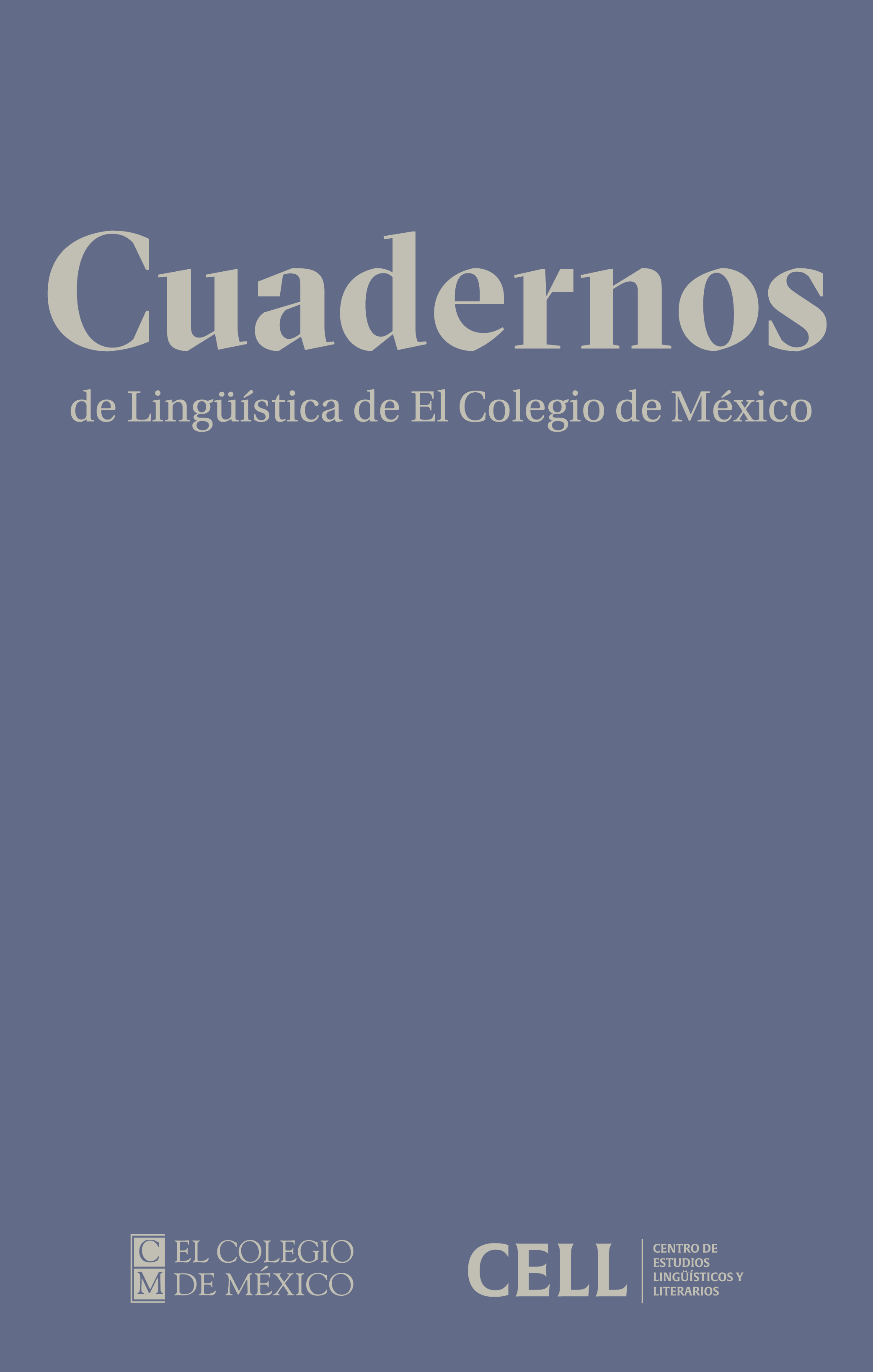Preverbos in Yucatec Mayan
DOI:
https://doi.org/10.24201/clecm.v11i00.309Keywords:
adverbs, adverbial modifications, Yucatec Maya, word classesAbstract
In linguistic descriptions of Mayan languages there is often a class of adverbs that exhibit exceptional behavior called “dependent adverbs”, “incorporated adverbs” or “clitic adverbs”, among other names. Their most notable characteristic is that they appear between the verb root and the set A bound pronoun or aspect marker in the clause. The objective of this paper is to present an argument in favor of the idea that, in Yucatec Maya, this adverbial class should be treated as its own lexical category that we label preverbos, which is distinct from adverbs. We present morphological, syntactic and semantic evidence in favor of distinguishing preverbos from both adverbs and from incorporated roots in compound verbal stems. Finally, we provide a detailed semantic classification of preverbos and propose a syntactic analysis that explains their grammatical properties.
Downloads
References
Aissen, Judith. 1987. Tzotzil clause structure. Dordrecht: Reidel. DOI: https://doi.org/10.1007/978-94-009-3741-3
AnderBois, Scott & Armstrong, Grant. 2016. On a transitivity-based split in Yucatec Maya control. (Manuscrito.)
AnderBois, Scott; Armstrong, Grant & Dzidz Yam, Edber. 2023. Yucatec Maya preverbs and the semantic typology of adverbs. (Actas de SULA 12, Ottawa, Canadá)
Andrade, Manuel. 1957. A grammar of modern Yucatec. (Microfilm Collection of Manuscripts on Cultural Anthropology, 7th series, no.41.) Beaver, David & Brady Clark. 2003. Always and only: why not all focus-sensitive operators are alike. Natural Language Semantics 11. 323–362. DOI: https://doi.org/10.1023/A:1025542629721
Blair, Robert. 1964. Yukatek Maya noun and verb morpho-syntax. Indiana University. (Tesis doctoral.)
Bohnemeyer, Jürgen. 2002. The grammar of time reference in Yukatek Maya. Múnich: Lincom.
Bohnemeyer, Jürgen. 2003. Verb compounding in Yukatek Maya: A complex predicate analysis. (Trabajo presentado SSILA 2003, Atlanta, GA, EEUU.)
Briceño Chel, Fidencio. 2006. Los verbos del maya yucateco actual. México DF: INALI
Bricker, Victoria; Po’ot Yah, Eleuterio & Dzul de Po’ot, Ofelia. 1998. A dictionary of the Maya language (as spoken in Hocabá, Yucatán). Salt Lake City: University of Utah Press.
Cinque, Guglielmo. 1999. Adverbs and functional heads: A cross-linguistics perspective. Oxford University Press. DOI: https://doi.org/10.1093/oso/9780195115260.001.0001
Clemens, Lauren & Coon, Jessica. 2018. Deriving verb initial word order in Mayan. Language 94. 237–280. DOI: https://doi.org/10.1353/lan.2018.0017
Coon, Jessica. 2016. Mayan morphosyntax. Language and Linguistics Compass 10/10. 515-550. DOI: https://doi.org/10.1111/lnc3.12149
Coon, Jessica. 2017. Little-v agreement and templatic morphology in Ch’ol. Syntax 20(2). 101–137. DOI: https://doi.org/10.1111/synt.12135
Ernst, Thomas. 2004. Principles of adverbial distribution in the lower clause. Lingua 114. 755–777. DOI: https://doi.org/10.1016/S0024-3841(03)00050-0
Ernst, Thomas. 2007. On the role of semantics in a theory of adverb syntax. Lingua 117. 1008–1033. DOI: https://doi.org/10.1016/j.lingua.2005.03.015
Gutiérrez Bravo, Rodrigo & Monforte, Jorge. 2010. On the nature of word order in Yucatec Maya. En Camacho, José; Gutiérrez Bravo, Rodrigo & Sánchez, Liliana (eds.) Information structure in indigenous languages of the Americas, 139-170. Berlín: Mouton de Gruyter. DOI: https://doi.org/10.1515/9783110228533.139
Hofling, Charles Andrew. 2000. Itzaj Maya Grammar. Salt Lake City, UT: University of Utah Press.
Knowles, Susan Marie. 1984. A descriptive grammar of Chontal Maya (San Carlos Dialect, Tabasco). Tulane University. (Tesis doctoral.)
Kramer, Ruth. 2014. Clitic doubling or object agreement: the view from Amharic. Natural Language & Linguistic Theory 32. 593–634. DOI: https://doi.org/10.1007/s11049-014-9233-0
Lehmann, Christian. 1993. Predicate classes in Yucatec Maya. Función 13-14. 195-272.
Lois, Ximena & Vapnarsky, Valentina. 2003. Polyvalence of root classes in Yukatekan Mayan languages. Múnich: Lincom.
Lois, Ximena & Vapnarsky, Valentina. 2006. Root indeterminacy and polyvalence in Yukatekan Mayan languages. En X. Lois & V. Vapnarsky (eds.) Lexical categories and root classes in Amerindian languages, 69-115. Bern: Peter Lang.
Maienborn, Claudia & Schaefer, Florian. 2011. Adverbs and adverbials. En Maienborn, Claudia; von Heusinger, Klaus & Portner, Paul (eds.) Semantics. An international handbook of natural language meaning, 1390–1419. Berlín: Mouton de Gruyter.
Mateo Toledo, B’alam. 2008. The family of complex predicates in Q’an- job’al (Maya): their syntax and meaning. Universidad de Texas-Austin. (Tesis doctoral.)
Mateo Toledo, B’alam. 2012. Complex predicates in Q’anjob’al (Maya): The verbal resultative. International Journal of American Linguistics 78(4). 465–495. DOI: https://doi.org/10.1086/666931
Matushansky, Ora. 2006. Head movement in linguistic theory. Linguistic Inquiry 37. 69–109. DOI: https://doi.org/10.1162/002438906775321184
May May, Ismael. 2011. Ka’aj máanen te’elo’ tu lu’umil Mayab (Cuando pasé por ahí, en la tierra del Mayab). Mérida, Yucatán: Instituto de Cultura de Yucatán.
McConnell-Ginet, Sally. 1982. Adverbs and logical form: A linguistically realistic theory. Language 58. 144-184. DOI: https://doi.org/10.2307/413534
Morzycki, Marcin. 2016. Modification. Cambridge, RU: Cambridge University Press.
Nevins, Andrew. 2011. Multiple agree with clitics: Person complementarity vs omnivorous number. Natural Language & Linguistic Theory 29. 939–971. DOI: https://doi.org/10.1007/s11049-011-9150-4
Osorio May, José del Carmen. 2005. Análisis de la morfología verbal del yokot’an, ‘Chontal’ del poblado de Tecoluta, Nacajuca, Tabasco. CIESAS. (Tesis de maestría.)
Petatillo Chan, Rodrigo. 2020. Los predicados complejos en el maya yu- cateco. CIESAS. (Tesis de maestría.)
Polian, Gilles. 2013. Gramática del Tseltal de Oxchuc. México DF: CIESAS/Publicaciones de la Casa Chata.
Royer, Justin & Alonso-Ovalle, Luis. 2019. Random choice modality in Chuj: The case of ‘komon’. (Proceedings of Form and Analysis in Mayan Linguistics (FAMLi) 5.) Santa Cruz, CA: UC Santa Cruz.
Schäfer, Martin. 2008. Resolving scope in manner modification. En Bo- nami, Olivier & Cabredo Hofherr, Patricia (eds.) Empirical Issues in Syntax and Semantics 7, 351–372.
Sullivan, Paul. 1984. Noun incorporation in Yucatec Maya. Anthropological Linguistics 26. 138–160.
Vázquez Álvarez, Juan Jesús. 2011. A grammar of Chol, a Mayan language. Universidad de Texas-Austin. (Tesis doctoral.)
Verhoeven, Elisabeth. 2007. Experiential constructions in Yucatec Maya: a typologically based analysis of a functional domain in a Mayan language. Ámsterdam: John Benjamins. DOI: https://doi.org/10.1075/slcs.87
Published
How to Cite
-
Abstract577
-
PDF (Español)255
-
XML (Español)21
-
EPUB (Español)12
-
Kindle (Español)31
-
MP3 (Español)0
Issue
Section
License
Copyright (c) 2024 Grant Armstrong, Scott AnderBois, Edber Dzidz Yam

This work is licensed under a Creative Commons Attribution-NonCommercial-NoDerivatives 4.0 International License.
Authors retain copyright of their work and are free to disseminate it, make copies for any use, and/or deposit in any repository or archive of their choice, but they grant Cuadernos de Lingüística de El Colegio de México the right to publish the work for the first time. Authors agree to acknowledge Cuadernos de Lingüística de El Colegio de México as the site of original publication of their article / note / review through proper citation.
Articles appearing in Cuadernos de Lingüística de El Colegio de México are made available to readers under a Attribution-NonCommercial-NoDerivatives 4.0 International.









